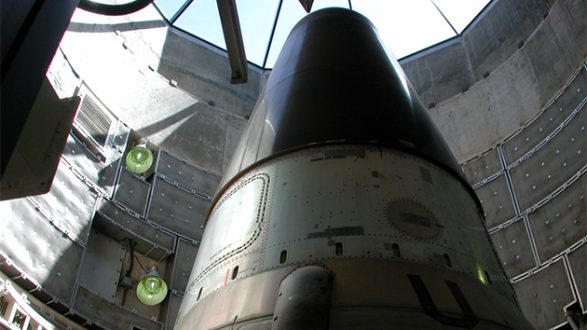
 iStock/Thinkstock(WASHINGTON) — The Pentagon has begun a Nuclear Posture Review that will guide the strategy for the U.S. military’s nuclear weapons programs and modernization of the nuclear triad over the next decade. The new review will also factor in the current geopolitical reality of frayed relationships with Russia and China that were not present during the last review conducted in 2010.
iStock/Thinkstock(WASHINGTON) — The Pentagon has begun a Nuclear Posture Review that will guide the strategy for the U.S. military’s nuclear weapons programs and modernization of the nuclear triad over the next decade. The new review will also factor in the current geopolitical reality of frayed relationships with Russia and China that were not present during the last review conducted in 2010.
“The Nuclear Posture Review is a legislatively-mandated review that establishes U.S. nuclear policy, strategy, capabilities and force posture for the next five to ten years,” reads the Defense Department’s website for the review.
President Donald Trump signed an executive order on Jan. 27 that, among other things, directed the Pentagon to conduct the Nuclear Posture Review this year.
According to a Pentagon statement issued Monday, the review will “ensure the U.S. nuclear deterrent is safe, secure, effective, reliable and appropriately tailored to deter 21st-century threats and reassure our allies.”
How many nuclear weapons does the U.S. have?
The review will be led by Bob Work, the deputy defense secretary, and Gen. Paul Selva, the vice chairman of the Joint Chiefs of Staff, and include other agencies, in particular the Energy Department, which is responsible for American’s nuclear weapons stockpile.
A final report is expected to be presented to Trump by the end of the year.
The 2010 Nuclear Posture Review for the first time prioritized the prevention of nuclear proliferation and nuclear terrorism. It also defined steps for strengthening existing non-proliferation norms, the securing of nuclear materials around the globe and holding accountable states and nonstate actors involved in proliferation.
According to a Defense Department fact sheet the U.S. also affirmed it would “not use or threaten to use nuclear weapons against non-nuclear weapons states that are party to the Nuclear Non-Proliferation Treaty (NPT) and in compliance with their nuclear nonproliferation obligations.”
“The United States would only consider the use of nuclear weapons in extreme circumstances to defend the vital interests of the United States or its allies and partners,” the fact sheet adds.
That earlier review was also conducted at a time when diplomatic relations with Russia were much better than they are now. Relations soured in early 2014 after Russia annexed Crimea, provided military troops to Russian separatists in eastern Ukraine and moved Russian troops into Syria to support the Assad regime.
Last week, Trump characterized the state of U.S. and Russian relations as possibly being “at an all-time low”.
The 2010 review also aligned a reduction in the U.S. nuclear weapons stockpile with the New START Treaty with Russia.
Under that treaty, the U.S. and Russia have committed to reduce their deployed nuclear weapons stockpiles to 1,550 by February 2018. That is the number of nuclear warheads that can be deployed on intercontinental ballistic missiles (ICBMs), submarines or heavy bombers by the U.S. and Russia.
The United States currently has 1,411 deployed warheads and Russia has 1,765. The higher number of Russian warheads is attributed to an ongoing modernization program.
While Russia has abided by the New START Treaty, the U.S. has accused it of violating the 1987 Intermediate Nuclear Forces Treaty by deploying a new nuclear-capable land-based cruise missile.
Current tensions in Asia with North Korea and China will also likely factor into the new review. Since 2010, North Korea has made significant strides in its ballistic missile and nuclear weapons program that have the stated goal of placing a nuclear warhead atop a long-range missile capable of reaching the American mainland.
“The president has made clear that he will not accept the United States and its allies and partners in the region being under threat from this hostile regime with nuclear weapons,” Lt. General H.R. McMaster, the national security adviser, told ABC’s “This Week” on Sunday.
The security relationship with China has also deteriorated with its territorial claims in the South China Sea, where it has built military-capable facilities on seven artificial islands.
The review will likely also have to take into account the Pentagon’s planned modernization program of its nuclear triad: strategic bombers carrying nuclear weapons, ICBMs and submarine-launched ICBMs.
While the Pentagon has undergone a modernization process to keep these decades-old systems viable, it has plans to replace each leg of the triad in the coming decades.
The initial phase of modernization over the next decade could cost $400 billion beginning in 2021, according to initial estimates. With additional work needed after that, there estimates that the modernization of the nuclear triad could cost $1 trillion.
But the replacements for the Air Force’s 450 Minuteman III missiles, a new long-range strategic Air Force bomber and a replacement the Navy’s submarine ballistic missile fleet are still at least a decade away from becoming a reality.
Copyright © 2017, ABC Radio. All rights reserved.










